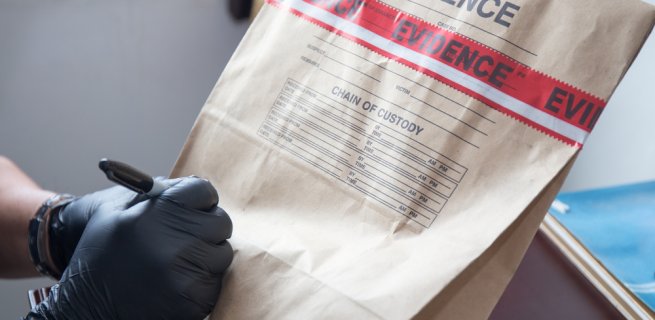Circumstantial evidence is evidence which does not directly link a person to a crime, but a particular fact or collection of facts that may infer their guilt. Even innocent people may appear condemned by circumstantial evidence, so is it enough to secure a conviction?
Courts have consistently upheld the proposition that circumstantial evidence can be enough to convict, and there have been a number of recent cases where juries have convicted defendants without any direct evidence of their guilt.
Juries can draw an inference of guilt from a combination of facts, none of which viewed alone would be enough to convict.
The most frequently used example is the “smoking gun”- where someone walks into a room and sees a deceased person on the floor and a man standing nearby with a smoking gun in hand pointing in the deceased’s direction.
While the witness did not actually see the man shoot the deceased, the other circumstances give rise to a strong inference that he is responsible for the shooting.
In circumstantial cases, if there is evidence of a “reasonable hypothesis consistent with innocence” then the defendant must be found “not guilty”. However, if there is no such reasonable explanation, the jury can infer guilt and find the defendant guilty.
The Baden-Clay case:
In the famous Baden-Clay case, there was no direct evidence linking Gerard Baden-Clay to the murder of his wife Allison – no official cause of death was given, there was no confession, no witnesses or murder weapon.
Instead, the prosecution relied on several pieces of circumstantial evidence in court, including that:
- Allison made preparations to attend a conference the day after her murder;
- Baden-Clay was involved in an affair and told the other woman he would leave Allison and would be “separated by 1 July”;
- Baden-Clay was financially struggling,and would receive almost $1 million death benefits from Allison;
- A relationship counsellor told Allison and Baden-Clay that they should set aside 10-15 minutes every second night so Allison could explain the impact that the affair had on her to her husband;
- On the night Allison was killed, several nearby residents heard yelling, a female voice screamed, a dull thud and a car leaving;
- Allison’s blood was found in the back of the recently-acquired family car;
- Residents who lived near where Allison’s body was found heard noises the night she disappeared including thuds and the sound of a car door being shut;
- Analysis of Baden-Clay’s mobile phone was inconsistent with his statement to police that he was asleep between 10pm and 6am;
- Despite extensive inquiries, only one witness noticed a person matching Allison’s description walking in the area, making it unlikely that she took her early morning walk, let alone that she walked the distance to the area where her body was found.
On their own, these facts may not amount to much, but put together, the jury evidently found them convincing enough to find Baden-Clay guilty.
He was sentenced to life imprisonment with a non-parole period of 15 years.
There are two different types of circumstantial evidence: “strands in a cable” and “links in a chain.”
The “Strands in a cable case”
The usual circumstantial evidence case is sometimes referred to as a “strands in a cable case”.
In this case, each piece of information is not particularly damning, but like a piece of cord, all the strands of evidence together make a strong case. In these cases, no single piece of evidence will conclusively prove the guilt of the accused, but juries are asked to accept that certain facts occurred, and from them to draw the conclusion of the existence of further facts.
In the often-cited case of Re Belhaven and Stenton Peerage, the judge described it as follows:
“You may have a ray of light so feeble that by itself it will do little… But on the other hand, you may have a number of rays, each of them insufficient, but all converging and brought to bear upon the same point, and, when united, producing a body of illumination which will clear away the darkness.”
Juries must only convict if they are convinced beyond reasonable doubt that the only reasonable inference or conclusion that can be made when considering the facts is the guilt of the accused person.
“Link in a chain case”
It may not be necessary in a circumstantial case, or any case for that matter, for the prosecution to prove every single fact that it asserts.
But there will be certain facts that are essential to proving the defendant’s guilt. These facts, known as “intermediate facts” will be indispensible to proving the guilt of the defendant, and must each be proved beyond reasonable doubt. Such facts are sometimes called the “links in the chain of guilt”.
It is up to each jury to decide whether or not any given fact has such significance.
Circumstantial vs direct evidence
Circumstantial evidence is not legally regarded as any less reliable than direct evidence in court – and, in some cases, it can even be considered to be more reliable – such as in the “smoking gun” example.
Indeed, direct evidence can have its own problems. For example, having eye-witnesses may make a case appear bullet-proof, but eye-witnesses are often mistaken as to significant facts, especially when it comes to identifying alleged offenders. Even witnesses who honestly believe that they have correctly identified an offender have been proven to be mistaken, and direct evidence such as identification evidence is not necessarily reliable.
If you have been charged with a serious crime, it is best to get legal advice from experienced trial lawyers as soon as possible.











